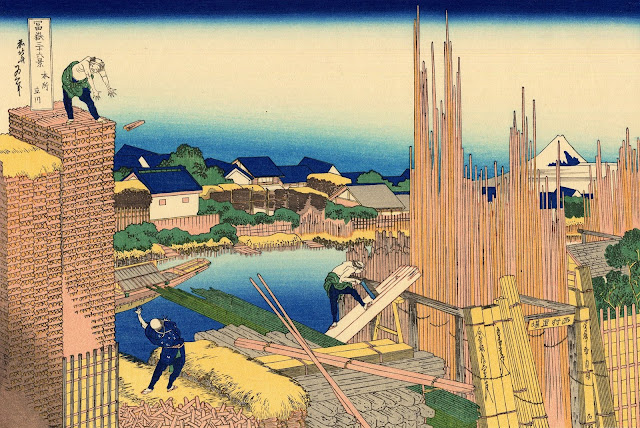KAMISAKA SEKKA / 神坂 雪佳 (1866 - 1942)
Fujiyama / 富士山 (3, 776 m -12,389 ft)
Japan
In Fuji - From Momoyogusa (A World of Things), 1909-1910
The New York Public Library Digital Collections
The artist
Kamisaka Sekka / 神坂 雪佳,was an important artistic figure in early twentieth-century Japan.
Born in Kyoto to a Samurai family, his talents for art and design were recognized early. He eventually allied himself with the traditional Rinpa school of art. He is considered the last great proponent of this artistic tradition. Sekka also worked in lacquer and in a variety of other media.
As traditional Japanese styles became unfashionable (such as Rimpa style), Japan implemented policies to promote the country's unique artistic style by upgrading the status of traditional artists who infused their craft with a dose of modernism.
In 1901, Sekka was sent by the Japanese government to Glasgow where he was heavily influenced by Art Nouveau. He sought to learn more about the Western attraction to Japonism, and which elements or facets of Japanese art would be more attractive to the West. Returning to Japan, he taught at the newly opened Kyoto Municipal School of Arts and Crafts, experimented with Western tastes, styles, and methods, and incorporated them into his otherwise traditional Japanese-style works. While he sticks to traditional Japanese subject matter, and some elements of Rimpa painting, the overall effect is very Western and modern. He uses bright colors in large swaths, his images seeming on the verge of being patterns rather than proper pictures of a subject; the colors and patterns seem almost to "pop", giving the paintings an almost three-dimensional quality.
His vision of MountFuji (above) is quite in this style.
The legendary Mount Fuji (富士山) is located on Honshu Island and is the highest mountain peak in Japan at 3,776.24 m (12,389 ft). Several names are attributed to it: "Fuji-san", "Fujiyama" or, redundantly, "Mt. Fujiyama" or simply "Fuji."
Mount Fuji is an active stratovolcano that last erupted in 1707–08.
Fuji lies about 100 kilometres (60 mi) south-west of Tokyo, and can be seen from there on a clear day. Fuji's exceptionally symmetrical cone, which is snow-capped several months a year, is a well-known symbol of Japan and it is frequently depicted in art and photographs, as well as visited by sightseers and climbers.
Mount Fuji is one of Japan's Three Holy Mountains (三霊山) along with Mount Tate and Mount Haku. It is also a Special Place of Scenic Beauty and one of Japan's Historic Sites.
It was added to the World Heritage List as a Cultural Site on June 22, 2013. As per UNESCO, Mount Fuji has “inspired artists and poets and been the object of pilgrimage for centuries”. UNESCO recognizes 25 sites of cultural interest within the Mt. Fuji locality. These 25 locations include the mountain itself, Fujisan Hongū Sengen Shrine and six other Sengen shrines, two lodging houses, Lake Yamanaka, Lake Kawaguchi, the eight Oshino Hakkai hot springs, two lava tree molds, the remains of the Fuji-kō cult in the Hitoana cave, Shiraito Falls, and Miho no Matsubara pine tree grove; while on the low alps of Mount Fuji lies the Taisekiji temple complex, where the central base headquarters of Nichiren Shoshu Buddhism is located.
Mount Fuji is one of Japan's Three Holy Mountains (三霊山) along with Mount Tate and Mount Haku. It is also a Special Place of Scenic Beauty and one of Japan's Historic Sites.
It was added to the World Heritage List as a Cultural Site on June 22, 2013. As per UNESCO, Mount Fuji has “inspired artists and poets and been the object of pilgrimage for centuries”. UNESCO recognizes 25 sites of cultural interest within the Mt. Fuji locality. These 25 locations include the mountain itself, Fujisan Hongū Sengen Shrine and six other Sengen shrines, two lodging houses, Lake Yamanaka, Lake Kawaguchi, the eight Oshino Hakkai hot springs, two lava tree molds, the remains of the Fuji-kō cult in the Hitoana cave, Shiraito Falls, and Miho no Matsubara pine tree grove; while on the low alps of Mount Fuji lies the Taisekiji temple complex, where the central base headquarters of Nichiren Shoshu Buddhism is located.
___________________________________________
2019 - Wandering Vertexes...
by Francis Rousseau


















